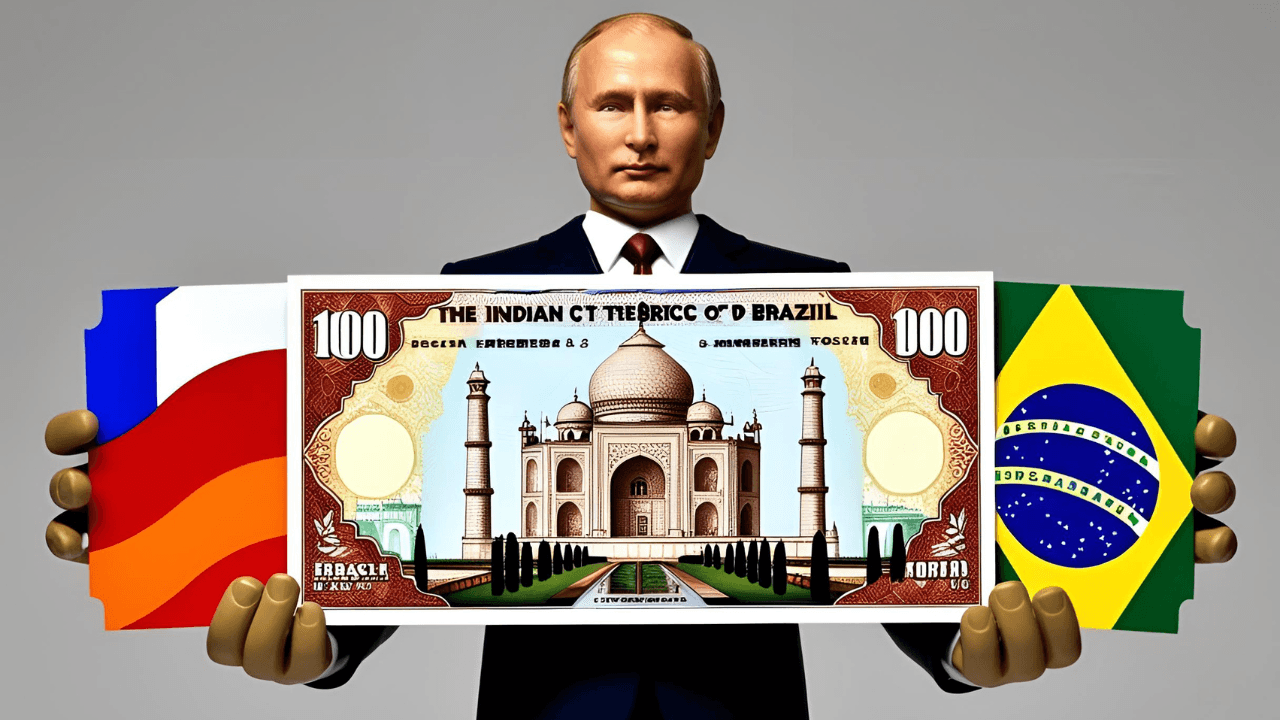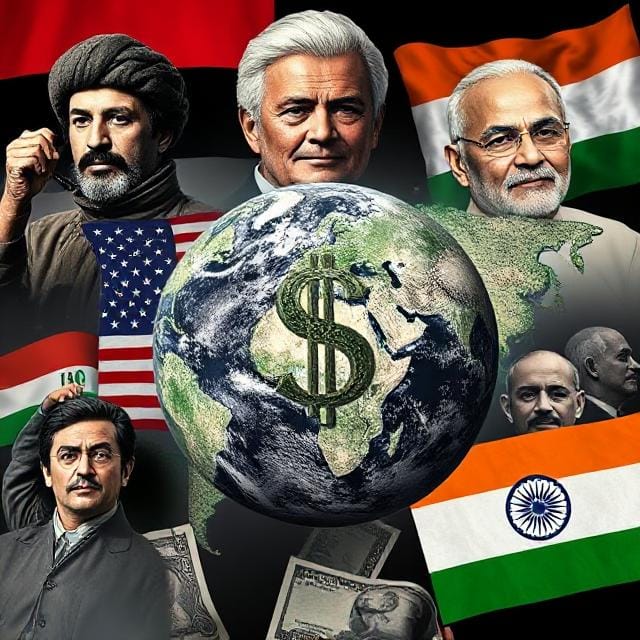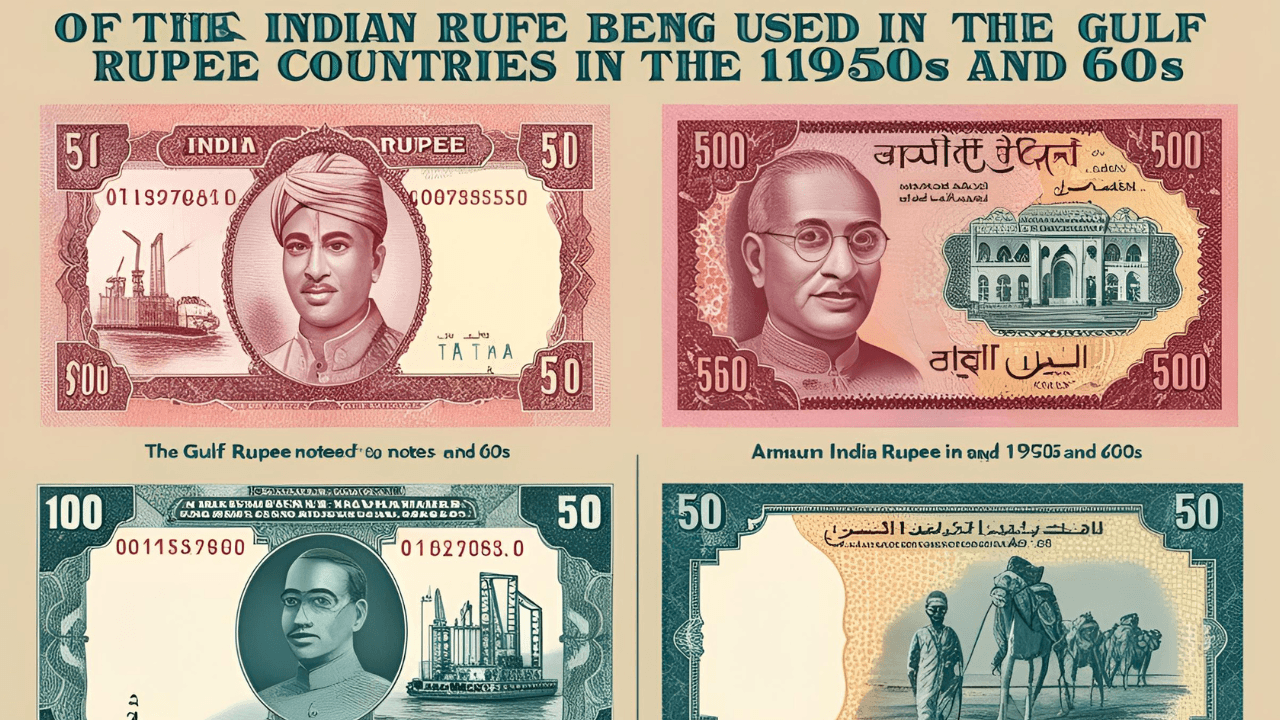Introduction to the BRICS Bank Note
You can see this note in Putin’s hand. It has the Indian flag as well as the photo of our Taj Mahal printed on it. This is a bank note, which was launched by Russia in the 16th BRICS summit held in Kazan. And since then, a new note has been launched all over the world.

Symbolism of the BRICS Bank Note
At the summit, Putin showed a symbolic BRICS bank note. The symbols of the founding countries of BRICS can be seen on the front side of the banknote. You will get to know about Russia, India, China, and Brazil through the symbolic BRICS bank note.
The Challenge to the US Dollar by BRICS
Can the BRICS countries challenge the dominance of the US dollar? Any BRICS state that even mentions the destruction of the dollar will be charged a 150% tariff.
And so far, there are 14 such countries in Potancheli that have agreed to use this BRICS currency in place of the dollar to break the monopoly of the US. Obviously, the US is not happy at all with this, especially India.
India’s Gold Purchases and US Concerns
In June 2024, the prominent US think tank The Atlantic Council published a report exposing India. The Reserve Bank of India (RBI) has been accumulating a lot of gold since 2017. And in 2024, India will be the world’s second-largest gold buyer.
Basically, RBI’s gold purchase increased four times in just one year, from 2023 to 2024. This may seem like a normal thing for civilians, but in the eyes of the US, this is a serious crime for which punishment is required.
The US Invasion of Libya in 2011
Tell me, why did the US invade Libya in 2011? Because the dictator there, Muammar Gaddafi, was oppressing the people. He was violating human rights, right? This is what we have heard.

Now let’s hear the truth. From Hillary Clinton’s leaked emails, it was revealed that Gaddafi had collected about 150 tons of gold and the same amount of silver in Libya, with which he wanted to create a new central currency for all African countries, the Libyan Dinar.
Now if this had happened, then obviously the dominance of the dollar would have started to diminish. In the language of geopolitics, this is called de-dollarization, and the US does not accept this at all. That is why the US then started a war with NATO powers.
But in this power politics, the Libyan people came in the way. As soon as NATO forces removed Gaddafi, the economy of the country collapsed. 325,000 people became poor in one go. Inflation started skyrocketing. Prices of basic items increased by 50%. In fact, only one emergency hospital was left in the entire country. Such was the situation.
And on top of that, NATO forces were mistakenly carrying out airstrikes on many civilians. So, collateral damage was inevitable. NATO has said technical failure was behind its destruction on Sunday of a residential building in Libya’s capital, where officials said 9 civilians were killed. In the name of humanitarian intervention, there was devastation all around.
The US Invasion of Iraq and the Petrodollar
The same happened in Iraq. The US even told the world that it attacked Iraq because it suspected that Saddam Hussein was hiding weapons of mass destruction in his country. For more than a decade, the United States and other nations have pursued patient and honorable efforts to disarm the Iraqi regime without war. That regime pledged to reveal and destroy all.

Meaning, the same classic reason was given for human rights violations. But here too, the truth was something else. There is a book called Petrodollar Warfare, and it is clearly written in it that just 3 months before this invasion, Saddam Hussein had decided that he would stop using the dollar and start selling oil in euros.
The United States and its allies prevailed. NATO forces attacked in such a way that the whole country was transformed in a few days. 40 lakh children became orphans due to the US invasion. Oil-rich Iraq was included in the list of the poorest countries in the world, and till today no stable government has been formed there. That is why Iraq became the target of ISIS.
The Ambition of India to Challenge the US Dollar
Then why has India set out to fight a superpower like the US? Is today’s new India also dreaming like Gaddafi and Saddam Hussein? To make our humble Indian rupee a global currency like the dollar?
Well, let’s keep all this nonsense aside for two minutes and just look at this note. In the 1950s, almost the entire Middle East used to use the rupee instead of the dinar or dirham. The Gulf nations had no currency of their own.
India’s Rise and Fall as a Global Currency
And we were soon going to become a reserve currency for the whole world, like the dollar, when, in 1960, we lost it.
But before discussing that incident, one thing is for sure: if India really wants to reduce its dependency on the US dollar, then a strong and self-reliant economy is needed, and what is the foundation of a strong economy?
Construction Industry Challenges and Udoo Management Solutions
In the construction business, the biggest task for companies is to manage vendors, inventory, quotations, and projects. In fact, it is explicitly written in the report of IIT Kanpur that the biggest challenge for Indian construction companies is project management, and to overcome it and survive it, it is very important to adopt new management technology. Now I know the challenge before construction companies is how to choose a reliable management technique.

Well, let me tell you, 12 million trusted customers in the industry still choose Udoo because Udoo makes your business easy. There are many options available in it, be it for sales, manufacturing, invoicing, etc.
Here you can sign up for a 15-day free trial of Udoo now and explore all the features and options of Udoo comfortably. In Udoo, emails from new clients are automatically converted into leads. This client can also use them.
Using the product catalog is also very fast. I go to Doors and select the product from the product category. Like, I am adding 3 sliding doors, 2 double doors, and 5 single doors. In the renovation industry.
We can now send quotations via text or email in one click, and then it will look like this to the customer. Once the customer e-signs the contract, the order gets automatically confirmed, and then the renovation project gets automated.
It is easy to navigate through all the operations of our renovation project through the top bar. I have tasks, material purchases, material requests from the central warehouse, dashboards, and much more, and most importantly, employee timesheets and even invoices.
First, we meet the architect who has planned out this renovation project, and most of the time, we will update it in the project, and he can do this even from his mobile. I can document it in the customizable top bar.
To make this view also easily accessible, we can hide the top bar. If I want to know which of my employees spent how much time on this project, I can see that here from the timesheet. Now, when new materials arrive at the job site, our project manager can easily validate the receipt of the products using the barcode of Udoo.
Now if I have to plan the working day or shift of my site engineers, then, moving forward, we can use the dashboard to manage everything—profitability, timesheets, planning, and invoicing. Now it is the turn of invoicing. We send the invoice of the time taken and the material used to the customer from here, and it is done in just 2 clicks. That was it. For the perfect seamless management of your construction business, there are many things here.
By clicking on the link given in the description below. Now, coming back to our topic, diversification of rupees. Because in the 1950s-60s, Rupee was heavily dependent on the medalists. So, due to a change in the 1960s, our rupee became a global currency.
The Gulf Rupee and India’s Missed Opportunity
Look, Gulf countries were using Indian rupees since the British Raj. Because these were also British colonies. After this, after getting independence until the 1950s, they continued to use Indian currency instead of printing their own currency.
So to stop this, in 1959, RBI introduced a special Gulf Rupee. This pink-colored Z1 series note was valid only in Gulf countries. Apart from this, because India had a great influence in Saudi Arabia, Indian Muslims going for Haj were also allowed to use it.
Devaluation of the Indian Rupee in the 1960s
The 1962 Sino-Indian War, the 1965 Indo-Pakistan War, and the infamous Bihar Drought of 1966—all these incidents happened, and one after the other, problems kept increasing for India. We were not able to export, and our imports had increased suddenly. India had to bear the entire burden of this.
To deal with this, India devalued the value of the rupee by 57% at all times. Due to which our currency went from 4 rupees per dollar to 7.50 rupees per dollar. Now, obviously, Gulf countries got scared. They felt that if the currency goes up, then the US will be able to use it.
End of the Gulf and Haj Rupee
In response to this, RBI also had to stop printing Gulf and Haj rupees. And unfortunately, the Indian rupee kept on becoming a global currency. We missed a golden opportunity because later on, these rupees would have become global currency.
Now think if the Indian rupee would have been their currency even then, how much higher would have been the value of the rupee today? Just for your context, Kuwait used the rupee earlier; today, the value of its currency, the value of one dinar (KWD), is equal to $3.25. A similar value of Oman’s and Bahrain’s currency is also there.
The Current Global Dependence on the US Dollar
All this is the past. Today we all know that 96% of the global trade is done using the US dollar. Which is a huge threat for every country in America, especially because the US knows very well how to abuse its power and influence on other countries.




Pingback: How China became a Superpower? | Case Study